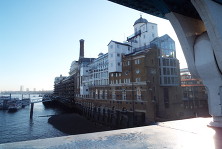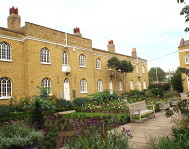








St Saviour's War Memorial
The St Saviour’s War Memorial that commemorates the fallen from the parish of St Saviour’s in the First World War was erected in 1922 and designed by Captain Philip Lindsay Clark DSO. It depicts an advancing, fully kitted infantryman, and bronze reliefs on the pedestal show scenes that represent the Navy and the RAF. On the short side facing south is a stone relief of St George and the Dragon, representing Victory over evil, and on the side facing north there is “a standing, grieving, veiled woman with a naked baby and a dove at her feet, symbolising 'the grief of the present generation [and] the hope of assumed peace of future generations” (from the PMSA website). The names of the fallen are inscribed in a memorial under another carved relief of St George and the Dragon behind the high alter in Southwark Cathedral.
Left: bronze reliefs depicting the Navy and the RAF
Right: Tablet in Southwark Cathedral where the names of those from the parish of St Saviour's who fell in the First World War are inscribed.
The war memorial is situated at the north end of Borough High Street, just before Southwark Street, on a small, triangular piece of land. The war memorial provides a focus for the community in the 20th and 21st centuries, but this pocket of land has provided a religious and later a civic focus that dates back to the 12th century.
The medieval St Margaret’s Church was located here and where the War Memorial now stands once stood a cross. The section of road that ran south from the church was named St Margaret’s Hill. The church was owned by St Mary Priory (forerunner to Southwark Cathedral) and served as a parish church from the early 12th century. It was a small church with private pews, tiled floors, a steeple an a belfry with three bells.
The Priory was surrendered to Henry VIII during the Reformation in 1539. The congregation of St Margaret’s joined together with that of St Mary Magdalen, another parish within the bounds of St Mary Priory, and petitioned the King for the use of the Priory church. An Act of Parliament in 1540 ratified the union of the two parishes and a grant of the Rectory and Priory Church made at an annual rental of £49.5s.4d. The former priory church was renamed St Saviour’s in remembrance of nearby Bermondsey Abbey, also surrendered to Henry VIII during the Reformation, that had been dedicated to St Saviour.
The former church of St Margaret was converted into a session house and gaol and became known as St Margaret’s Hall or Justice Hall but was destroyed in the Great Fire of Southwark in 1676. A new session house and gaol were built and the new building had a statue of Charles II, who had received the freedom of Southwark, situated in an external alcove at the first floor level. The Sessions House was replaced by a Town Hall in 1793 but this building gradually deteriorated and was demolished to make way for a bank.
In 2013 the War Memorial was dismantled to allow for restoration works to the foundations which were failing. Two years earlier, one of the bronze panels disappeared, seemingly the result of an act of vandalism but was found shortly afterwards in the Slug and Lettuce. The panel had simply fallen off and was taken in by the bar for safe keeping. A service of rededication was held in March 2014 upon completion of the restoration works.
Web discoveries
- UK Casino Not On Gamstop
- UK Casino Not On Gamstop
- Non Gamstop Casino
- Casinos Not On Gamstop
- Non Gamstop Casinos
- Non Gamstop Casinos
- Non Gamstop Casino
- Casinos Not On Gamstop
- Casino Sites Not On Gamstop
- Slots Not On Gamstop
- Casinos Not On Gamstop
- UK Betting Sites Not On Gamstop
- UK Casino Not On Gamstop
- Best Non Gamstop Casinos
- Betting Sites
- Non Gamstop Casino Sites UK
- Best Non Gamstop Casinos
- Non Gamstop Casino
- Casinos Not On Gamstop
- Non Gamstop Casino Sites UK
- Horse Racing Betting